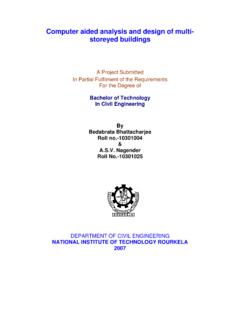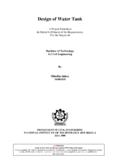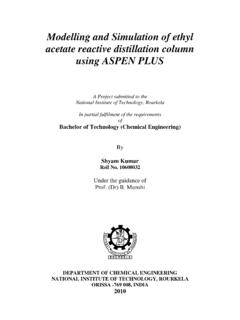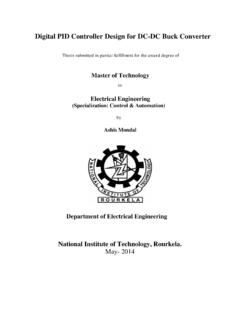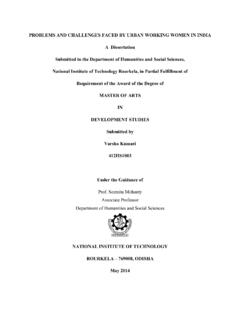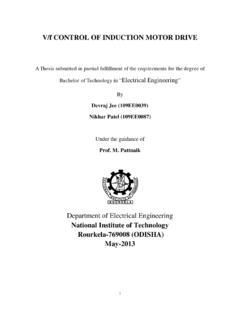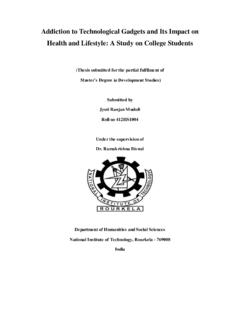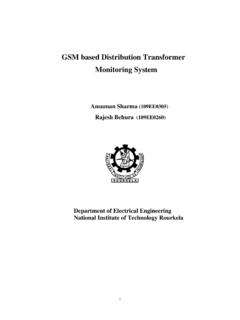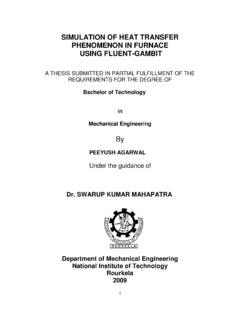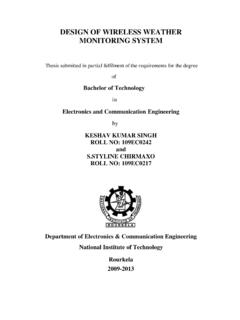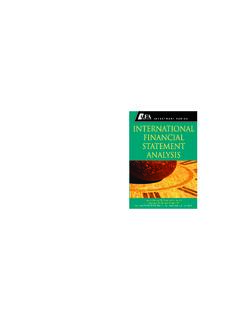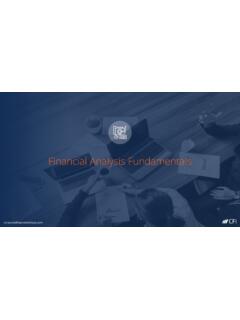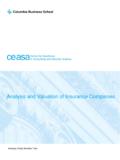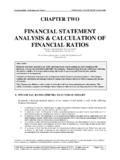Transcription of ANALYSIS AND INTERPRETATION OF FINANCIAL …
1 ANALYSIS AND INTERPRETATION OF FINANCIAL STATEMENTS: CASE STUDIES THESIS SUBMITTED IN PARTIAL FULFILLMENT OF THE REQUIREMENTS FOR THE DEGREE OF Bachelor of Technology in Mining Engineering By SUDIP DAS Roll: 10605038 DEPARTMENT OF MINING ENGINEERING NATIONAL INSTITUTE OF TECHNOLOGY, ROURKELA 2010 ANALYSIS AND INTERPRETATION OF FINANCIAL STATEMENTS: CASE STUDIES THESIS SUBMITTED IN PARTIAL FULFILLMENT OF THE REQUIREMENTS FOR THE DEGREE OF Bachelor of Technology in Mining Engineering By SUDIP DAS Roll: 10605038 Under the guidance of Prof. DEPARTMENT OF MINING ENGINEERING NATIONAL INSTITUTE OF TECHNOLOGY, ROURKELA 2010 National Institute of Technology Rourkela CERTIFICATE This is to certify that the thesis entitled ANALYSIS AND INTERPRETATION FINANCIAL STATEMENTS: CASE STUDIES submitted by Sri Sudip Das, Roll No: 10605038 in partial fulfillment of the requirements for the award of Bachelor of Technology degree in Mining Engineering at the National Institute of Technology, Rourkela (Deemed University) is an authentic work carried out by him under my supervision and guidance.
2 To the best of my knowledge, the matter embodied in the thesis has not been submitted to any other University/Institute for the award of any Degree or Diploma. Date: (Prof. TRIPATHY) Dept. of Mining Engineering National Institute of Technology Rourkela-769008 ACKNOWLEDGEMENT I wish to express my deep sense of gratitude and indebtedness to Dr. , Department of Mining Engineering, , Rourkela for introducing the present topic and for his inspiring guidance, constructive criticism and valuable suggestions throughout the project work. I am also thankful to all staff members of Department of Mining Engineering, NIT, Rourkela. Lastly, I would like to thank and express my gratitude towards my friends who at various stages had lent a helping hand. Date: (Sudip Das) i ABSTRACT FINANCIAL statements are formal records of the FINANCIAL activities of a business, person, or other entity and provide an overview of a business or person's FINANCIAL condition in both short and long term.
3 They give an accurate picture of a company s condition and operating results in a condensed form. FINANCIAL statements are used as a management tool primarily by company executives and investor s in assessing the overall position and operating results of the company. ANALYSIS and INTERPRETATION of FINANCIAL statements help in determining the liquidity position, long term solvency, FINANCIAL viability and profitability of a firm. Ratio ANALYSIS shows whether the company is improving or deteriorating in past years. Moreover, Comparison of different aspects of all the firms can be done effectively with this. It helps the clients to decide in which firm the risk is less or in which one they should invest so that maximum benefit can be earned. Mining industries are capital intensive; hence a lot of money is invested in it. So before investing in such companies one has to carefully study its FINANCIAL condition and worthiness.
4 Unfortunately very limited work has been done on ANALYSIS and INTERPRETATION of FINANCIAL statements of Indian for mining companies. An attempt has been carried out in this project to analyze and interpret the FINANCIAL statements of five coal and non- coal mining companies. OBJECTIVES To understand, analyze and interpret the basic concepts of FINANCIAL statements of different mining companies. INTERPRETATION of FINANCIAL ratios and their significance. Development of programs in C++ for calculation of different FINANCIAL statements and FINANCIAL ratios. Use of Tally package for the ANALYSIS and INTERPRETATION of FINANCIAL statements of mining companies. ii This project mainly focuses in detail the basic types of FINANCIAL statements of different companies and calculation of FINANCIAL ratios. Ratio ANALYSIS of five companies viz. ACC Ltd, Tata Steel, Jindal Steel & Power Limited, Hindustan Zinc Ltd.
5 (HZL) and Gujarat Mineral Development Corporation (GMDC) was done. Computer programs were developed in Turbo C++ for the preparation/ ANALYSIS of different FINANCIAL statements and ratios. However, only eleven ratios could be calculated with it. In near future the program can be upgraded to calculate more ratios. Tally was used for preparation of balance sheet, profit & loss statements and estimation of few FINANCIAL ratios of selected companies. Profit & Loss Statements of companies were not calculated as Tally has limitations in processing the data that was available. However, only three ratios viz. current ratio, quick ratio and debt-equity ratio were calculated. An advanced version can be developed for calculation of profit & loss statements and other FINANCIAL ratios. From ratio ANALYSIS of Balance Sheet and P & L Statement of ACC Ltd. of 2007-09 it was concluded that liquidity position of the company is not good.
6 Current ratio, debt-equity ratio, quick ratio, net profit margin, operating profit margin, gross profit margin, return on assets, return on investments and return on capital employed were found to be unacceptable. Short term liquidity position of JSPL in 2007 was good. However, current ratio, quick ratio, net profit margin, return on assets, return on investments and return on capital employed were unsatisfactory. The ratios that were found to be desirable are debt-equity ratio, operating profit margin and gross profit margin. In 2008-09, net working capital available with the company was adequate. The ratios that were found to be satisfactory are quick ratio, debt-equity ratio, return on investments, return on net worth, operating profit margin and gross profit margin. Current ratio, return on capital employed, return on assets and net profit margin of the company were unacceptable.
7 For Tata Steel in 2007, net working capital, quick ratio, return on investments, return on net worth, operating profit margin and gross profit margin of the company were satisfactory. However, debt-equity ratio, current ratio, net profit margin, return on capital employed and return on assets were undesirable. In 2008, only company s current ratio improved due to substantial increase in current assets position. In 2009, net working capital available was iii inadequate. Company s debt-equity ratio, operating profit margin and gross profit margin were desirable and current ratio, return on investments, return on net worth, return on capital employed and return on assets were found to be unsatisfactory. Short term liquidity position of HZL was good in 2007. The ratios that were found to be satisfactory are operating profit margin, gross profit margin, net profit margin, return on capital employed, return on assets and return on net worth.
8 Current ratio, quick ratio and debt-equity ratio were undesirable. In 2008, current assets position improved further that resulted in better current ratio and quick ratio. Debt-equity ratio was very low due to less investment. In 2009, return on capital employed, return on assets, return on investment and return on net worth remained unsatisfactory. For GMDC in 2007, net working capital available was adequate. Quick ratio, debt-equity ratio, operating profit margin and gross profit margin of the company was also desirable. However company s net profit margin, return on capital employed, return on assets, return on investment and return on net worth were undesirable. In 2008 & 2009, only debt-equity ratio of the company decreased as the debts have been cleared. In this project, comparison of different ratios viz. current ratio, debt-equity ratio, net profit margin and return on investment of all the above e companies has been done for the period was observed that current ratio of ACC Ltd.
9 Was always less than 1 from 2004 -09 which indicates that liquidity position of the company was not good. Current ratio of Jindal Steel & Power Ltd. and HZL was satisfactory as it remained more than 1 for all the five years. Liquidity position of Tata steel was not satisfactory as the ratio varied marginally from to in five years whereas current ratio of GMDC decreased from to D-E ratio of ACC Ltd. decreased from to from 2004 -07 and then increased to in 2009 which indicates the debts have been cleared. Debt position of JSPL was satisfactory as the ratio varied from to from 2004-09. GMDC s D-E ratio was from 2004-07 because of increasing investment and then came down to However D-E ratio of Tata Steel & HZL was less than 1 in five years as their debts were paid off. From 2004-09, net profit margin of HZL increased from to It remained the most profit making company compared to others due to their substantial increase in sales.
10 Profitability iv of ACC Ltd. varied marginally from to Profit Margin of GMDC came down from in 2004-05 to in 2008-09. Though sales of the company JSPL, Tata Steel and GMDC increased, their profit percentage decreased from 2004-09 due to their decrease in net profit. ROI of ACC Ltd. increased from to in five years due to substantial increase in its profit before tax. Similarly, ROI of GMDC increased marginally from to in five years. From 2004- 06, ROI of HZL increased from to and in 2009 it declined to ROI of Tata Steel was highest in 2004-05 with and then it declined to Similarly ROI of JSPL decreased from to v CONTENTS Sl. No. Title Page No. Chapter-01 INTRODUCTION 1 Objectives 1 Chapter -02 FINANCIAL STATEMENTS 2 Balance Sheet 2 Format of Balance Sheet 3 Contents of Balance Sheet 4 Profit and Loss Statement 9 Format of Profit and Loss Statement 9 Contents of Profit and Loss Statement 10 FINANCIAL Ratios 13 Objectives 13 FINANCIAL Ratios and their INTERPRETATION 14 Chapter -03 DEVELOPMENT OF PROGRAMME IN C++ FOR PREPARATION OF FINANCIAL STATEMENTS & RATIOS 22 Output for preparation of Balance Sheet 22 Output for preparation of Profit & Loss Statement 23 Output for calculation of FINANCIAL Ratios 24 vi Chapter -04 FINANCIAL RATIO ANALYSIS : CASE STUDIES 25 RATIO ANALYSIS 25 ACC Ltd.
